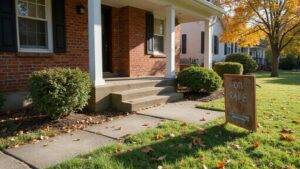Hoarding is a growing problem that affects many property owners. When clutter piles up, it can be much more than an eyesore. It often leads to hidden damage, safety risks, and major financial loss.
These issues make it harder to sell your home or get a good price. Buyers notice the mess and may worry about unseen problems.
Insurance and inspections become more complicated, and your neighbors may worry about property values, too. Hoarding can lower your property value by 10–25% compared to similar homes.
The good news is, you can take steps to fix the problem and protect your investment. Simple changes and expert help can make a big difference. This blog will guide you through practical ways to solve hoarding and restore your property value.
Key Takeaways
- Hoarding significantly reduces property value by making homes less appealing to buyers and increasing visible and hidden repair costs.
- Clutter and unsanitary conditions create safety hazards, fire risks, and code violations, which deter buyers and lower appraisals.
- Hoarding often hides structural damage, mold, and pest infestations, leading to expensive remediation and further devaluing the property.
- Properties with hoarding issues typically stay on the market longer and receive lower offers, sometimes decreasing value by 10-25%.
- The stigma and neighborhood impact of hoarding can reduce surrounding property values and overall community desirability.
Structural Damage and Its Financial Consequences

Hoarding can cause serious structural damage to your home. Heavy piles of items put too much weight on floors and walls. This extra pressure can lead to cracks, warping, or even collapse. If the structure becomes damaged, repairs can be very expensive.
You might need experts to reinforce or replace affected areas. Such issues are not just minor fixes. In some states like Virginia, sellers have legal disclosure requirements when it comes to revealing known property defects such as structural damage caused by hoarding or other factors. Potential buyers often avoid homes with visible structural problems.
If damage is ignored, your home’s value and marketability can drop a lot. This means you could lose a significant part of your investment. Repairing significant structural issues may also delay your ability to sell quickly, making it even harder to attract offers from cash buyers or those looking for a fast transaction.
Increased Risk of Fire and Insurance Implications
Hoarding increases the risk of fire in a home. Piles of paper, fabric, or cardboard can catch fire easily. Blocked exits and crowded pathways make it hard to escape during an emergency. Insurance companies may see hoarded homes as risky. Higher fire risk can mean higher insurance costs or loss of coverage. If hoarding causes a fire, insurance may not pay for all damages.
In addition, hoarded properties can suffer from hidden fire risks like electrical hazards or smoke damage that aren’t obvious at first but can impact both safety and long-term value. If these risks continue, your property value may go down. Homes with fire hazards are less attractive to buyers and investors.
This can make it harder to sell the home in the future. In some situations, you can sell your house as-is in Fishersville, even if there are safety or fire concerns due to hoarding, without needing to make costly repairs first.
Mold, Pests, and Sanitation Issues

Hoarding often causes mold, pest, and sanitation problems in homes. Clutter makes it hard to spot leaks or water damage. If water damage goes unnoticed, mold can grow and spread quickly.
Mold may damage walls, floors, and personal items. It can also cause health problems if not removed. According to cash buyers in Broadway, houses with major issues like mold or damage can be sold without the need for repairs.
Pest infestations are more likely if clutter provides hiding places and food. Rodents and insects thrive in messy spaces. Poor sanitation leads to bad smells and dirty surfaces. If these issues are ignored, they can lower your home’s value.
Regular cleaning and maintenance are important. These steps help prevent mold, pests, and sanitation problems. Proper care also keeps your home safe and comfortable.
If hoarding results in severe damage, some cash home buyers will still purchase the property as-is, avoiding the need for repairs before selling.
Diminished Curb Appeal
Diminished curb appeal happens when clutter appears outside a home. Hoarding often leads to items piling up in yards or on porches. This makes the property look neglected.
Overgrown grass and blocked walkways are common signs. These conditions can turn away buyers and lower a home’s value. Neighbors may also view the property more negatively. In some communities, local regulations in Virginia require prompt cleanup of visible clutter to prevent fines or further decreased property value.
If clutter is visible, buyers might not notice the home’s good features. Even with a strong structure, curb appeal matters a lot. First impressions can affect both interest and offers. Hoarded properties may also present health and safety hazards that further discourage potential buyers and decrease property value.
Difficulties in Home Inspections and Appraisals

When you encounter hoarding during a home inspection, you can’t properly assess the structure or identify hidden damage. These barriers introduce significant uncertainty into the appraisal process, making it difficult to determine an accurate market value. As a result, both buyers and lenders face increased risk and hesitation.
In these situations, working with cash home sales can expedite the process and minimize complications, especially when a quick sale is necessary. In fact, investment buyers are often prepared to purchase properties as-is, which provides a practical solution for sellers struggling with hoarding-related obstacles.
Obstructed Structural Assessments
Hoarding blocks access to important parts of a building. Inspectors cannot check the foundation, walls, or utilities if clutter is in the way. This makes accurate structural assessments impossible.
If professionals cannot see these areas, they may miss safety problems or damage. Reports may be incomplete, and issues might go unnoticed. This can cause delays or extra costs for more inspections.
Appraisers may lower the property value if they cannot inspect it fully. Limited access creates uncertainty in their reports. Cluttered spaces prevent a fair and thorough evaluation.
Hidden Damage Risks
Hoarding hides damage that threatens a property’s safety. Clutter can cover up water leaks, mold, or pest problems. If these issues are hidden, owners and inspectors cannot see the real condition.
Hidden hazards are often missed during home inspections. Some areas may be skipped if inspectors cannot reach them. Important electrical or plumbing problems may go unnoticed and can get worse.
If clutter blocks access, inspectors might have to guess about certain areas. This leads to incomplete or inaccurate reports. If this happens, repair costs may be higher than expected.
Unseen damage makes it hard to judge the true value of a property. Appraisals and inspections may not show all needed repairs. This creates uncertainty for buyers and sellers.
Appraisal Value Uncertainty
Hoarding creates uncertainty in home appraisal values. If clutter blocks access, appraisers cannot inspect all areas of the home. This makes it hard to give an accurate value.
Blocked rooms or closets prevent checking floors, walls, and plumbing. Appraisers may have to guess about hidden parts of the house. These guesses can lead to differences in property value.
If an appraiser cannot fully inspect a home, lenders and buyers may worry about hidden problems. This uncertainty can slow down or complicate a sale. Storage clutter adds risk and confusion to the home’s appraisal process.
Deterring Potential Buyers

A home with signs of hoarding quickly loses buyer interest. Clutter and too many belongings make rooms look smaller. Buyers may find it hard to picture their own things in the space.
If buyers see clutter, they might worry about hidden damage or poor maintenance. These concerns can lead them to look at other homes. Even if you say the house is in good shape, clutter can make them doubt your claims. In some cases, buyers may also be concerned about outstanding property liens that could complicate the sale.
In a busy market, buyers want homes that are ready to move into. Any sign of hoarding may lower your home’s value. If you want to attract more buyers, the space should look clean and open.
Additionally, evidence of hoarding can make buyers suspect the presence of hidden problems such as mold, water damage, or structural issues, which can further deter interest and negatively impact the sale.
Extended Time on the Market
You’ll notice that hoarding often leads to slower buyer interest, which keeps your property on the market longer than average. This extended timeframe introduces additional selling challenges, from maintaining the listing to managing ongoing costs. You need to recognize how these delays can further impact your property’s perceived value and final sale price.
Extended time on the market may also signal to buyers that there are underlying property condition concerns, prompting reduced offers or hesitation, which is why addressing hoarding-related issues quickly is crucial for a faster sale. Additionally, understanding how legal requirements & disclosures play a role in buyer confidence can help you make improvements that speed up the sale process.
Slower Buyer Interest
Visible hoarding makes it harder to sell a home quickly. Buyers cannot see the true space when clutter is present. This often causes them to lose interest early.
If sellers do not declutter, buyers may struggle to imagine living there. Emotional attachment to items can make decluttering difficult for homeowners. As a result, the home may stay on the market longer than similar properties.
If you address hoarding before listing, you might attract more buyers. A clean space can help improve your sale price and marketing strategy. Proper preparation is important for a faster sale.
Increased Selling Challenges
Hoarding makes it much harder to sell a home. Excess clutter turns buyers away and causes the property to sit on the market longer. If a home is full of clutter, buyers will often move on to other options.
Homes with storage issues get fewer offers. Buyers may think the space is too small or hard to use. If clutter is not managed, appraisers may lower the value.
Staging is also difficult in a cluttered home. Poor presentation makes it hard for buyers to see the home’s best features. If a home stays on the market too long, buyers may wonder if there are hidden problems.
If you want to sell quickly and at a good price, you must address these issues. Removing clutter and cleaning up will improve both value and appeal. Otherwise, you risk a lower sale price and fewer interested buyers.
Legal and Code Enforcement Challenges

Legal and code enforcement agencies often struggle to address hoarding in properties. Hoarding usually leads to health, safety, and building code violations. Authorities must act, but privacy laws can slow their response.
Code violations may include blocked exits, fire hazards, or unsanitary conditions. These problems can make the property legally unsafe or unlivable. Property owners may be held responsible for fixing these issues.
If legal action is needed, investigations and court orders may take a long time. Remediation is often required, but it can be delayed by legal rights and procedures. If you own a hoarded property, you may face lengthy and complex legal challenges. Additionally, selling a hoarded property as-is to cash buyers can sometimes bypass extended legal and repair processes, helping owners resolve violations more quickly.
Impact on Neighboring Property Values
You’ll find that hoarding often reduces curb appeal, making nearby homes less attractive to potential buyers. This decline can shift the overall market perception of your neighborhood, leading buyers to question property values and desirability. As a result, neighboring properties may experience slower sales and lower prices.
Curb Appeal Reduction
Hoarding can make a home look less attractive from the street. If clutter is visible outside, curb appeal drops right away. This can affect how others see your property and the neighborhood.
Visible clutter in yards or driveways may turn away possible buyers. If someone sees overflowing garages or messy porches, they may worry about safety. These storage issues can also make buyers think twice about moving in.
Lower curb appeal may decrease interest in homes nearby. A neglected home can lead others to care less for their own yards. This often causes the whole neighborhood to look less appealing.
If you keep your property tidy, you help maintain its value. Good curb appeal can attract buyers and support strong property values. Even small changes can make a big difference.
Neighborhood Market Perception
Hoarding in one home can lower the value of nearby houses. Buyers may see the neighborhood as less safe or cared for. This can make it harder to sell homes at good prices.
If your house is next to a hoarded property, buyers might hesitate to make offers. Even a well-kept home can be affected by its location. The stigma from hoarding can spread to the whole area.
Over time, this negative image may keep property values down. If enough buyers avoid the area, selling becomes more difficult. This impacts everyone in the neighborhood, not just one property.
Costs of Professional Cleanup and Restoration
Professional cleanup and restoration for hoarding can be expensive. Costs depend on the amount of work and the condition of the property. If you plan to hire help, you should know what expenses to expect.
Cleanup costs cover labor, hauling, and equipment to remove unwanted items. Restoration may require fixing damaged walls, floors, or dealing with mold and pests. If some belongings are valuable, storage fees could also apply.
You should estimate these costs before starting the process. Accurate estimates help you plan your budget and protect your property’s value. If costs are too high, consider seeking financial help or comparing several service providers.
Challenges in Securing Financing or Loans
Securing financing or loans for a hoarded property is often difficult. Lenders see clutter and storage problems as risks. They may hesitate to approve loans for homes with these issues.
Appraisers might find blocked access, safety problems, or damaged structures. These issues can lower the property’s value. If the risks are high, lenders might deny the loan completely.
If you want better loan terms, you must fix storage and clutter problems. Lenders may also ask for repairs or more inspections. Improving the property’s condition can increase your chances of getting a loan.
Decreased Rental Income Potential
Hoarding lowers the amount of money you can earn from renting your property. Clutter takes up valuable space and makes it harder to attract tenants. If the property is crowded with stored items, fewer people will want to live there.
Prospective tenants usually want a clean and spacious living area. Storage clutter can make them look for other rental options. This may also lead to tenants leaving quickly, causing frequent vacancies.
If owners are emotionally attached to belongings, cleanouts can be delayed. Longer vacancy periods mean less rental income each month. Removing clutter quickly can help maintain steady earnings.
Emotional and Social Effects on Value Perception
Visible hoarding can make a property seem less valuable than similar clean homes. Buyers and neighbors often see the home as less desirable. This perception can lower the property’s market value.
Owners may not notice the problem if they are emotionally attached. Buyers could feel uneasy or anxious about hoarding in a home. If this happens, buyers might avoid the property or offer less money.
Neighbors may view hoarding as a social issue. The stigma can reduce how much people want to live nearby. This can lower the value of surrounding homes as well.
These effects go beyond just visible clutter. They influence how buyers see risk and future enjoyment. If the reputation stays, the impact on value can last a long time.
Case Studies of Real Estate Impact
Real estate transactions are often impacted by hoarding. Homes with hoarding issues usually lose value and attract fewer buyers. Buyers and appraisers notice clutter and storage problems right away.
If a home has visible hoarding, it may sell for 10-25% less than similar homes. Cleanup and repair costs increase, which lowers the sale price. Properties with clutter usually stay on the market longer.
Appraisers may lower a home’s value if clutter blocks inspection or shows poor upkeep. If you are evaluating such properties, note these common patterns. These issues can affect both the sale price and speed of sale.
Conclusion
If you ignore hoarding, your property’s value can drop and sales may become more difficult. Potential buyers often avoid homes with clutter or hidden damage. Addressing hoarding helps protect your investment and attracts more interest.
If you want to sell quickly, we buy houses for cash in any condition. Align Real Estate Solutions offers a simple and stress-free process. You do not need to clean or repair before selling to us.
If you are ready to move forward, contact Align Real Estate Solutions today. We can help you sell your property fast and without hassle. Let us take care of the details so you can focus on your future.
Author
-

Zach Koops is co-founder and Real Estate Success Manager at Align Real Estate Solutions, serving homeowners across Virginia since 2024. With a passion for real estate and a heart for people, Zach has built his career around helping sellers navigate tough situations—foreclosure, inheritance, relocation, repair-overload—with clarity and compassion. He’s known for being straightforward, steady under pressure, and deeply invested in relationships. Outside of work, he spends his time as a husband and father, enjoys the outdoors in Shenandoah Valley, loves singing on stage, and constantly seeks growth through reading and new experiences.









